Exploring Creativity: Free AI Generators Unveiled
The introduction of free AI art generators has significantly impacted the art world, providing artists with new tools to push the limits of creativity. These platforms utilize advanced technology, including algorithms and machine learning, to enable the creation of art that goes beyond traditional forms. This shift prompts us to consider the future implications of such technology on art. We’ll look at how these generators function and what their growing popularity means for the art community. This discussion could offer fresh insights into the blend of creativity and technology.
Using AI to create art is not just about technology; it’s about reimagining what art can be. These generators offer a unique approach to creativity, allowing seasoned artists and newcomers to experiment with new styles and ideas. The impact on the art community is profound, fostering a space where innovation thrives. This evolution in art creation challenges us to rethink our definitions of art and the artist’s role in the digital age.
Key Takeaways
- AI art generators blend human creativity with technology.
- They democratize art, making it accessible to everyone.
- Raises questions about authorship and originality in art.
Understanding AI Art Generators
AI art generators are excitingly changing how we create, combining technology and art. These tools use algorithms to turn ideas into unique visual pieces. They can sift through vast amounts of data, producing art that blends the machine’s insights with the artist’s vision. Artists can pick from various styles, pushing the boundaries of classical and modern art.
The ability to tweak settings, select colors, and arrange compositions lets artists craft custom pieces that are hard to make by hand. This flexibility gets a boost when AI art tools link up with standard software, offering even more ways to personalize art. Unique algorithms are key here, creating one-of-a-kind effects and styles that expand what’s possible in art.
AI art generators aren’t just for making art; they’re platforms for trying new things and making genuinely different art. This mix of AI and creativity transforms how we see and make art, opening new paths for fun and professional growth.
Exploring Top Free Platforms

When we look at the top free AI art platforms, it’s interesting to note what sets each apart. For instance, NightCafe Creator offers a wide range of artistic styles, while Artguru brings to the table its ability to customize deeply. These platforms are more than just tools; they’re spaces where artists gather to push the limits of their creativity with the help of AI. This exploration highlights the technologies available for creating digital art and the community spirit that fuels progress and innovation in this field.
In today’s fast-paced world, keeping up with the latest digital art can be challenging, but these platforms make it easier. They’re not just for seasoned artists; beginners can dive in and start creating immediately. This is important because it shows how accessible and influential AI has become in art, enabling more people to express themselves creatively.
Popular AI Art Platforms
In the world of digital art, several platforms have risen to prominence, offering everyone the chance to experiment with art creation at no cost. These platforms have opened up new opportunities for people to unleash their creativity and share their work with a broader audience.
Wombo. Art is praised for its easy-to-use interface and many art styles. It welcomes both beginners and seasoned artists to bring their visions to life. Pixray on Replicate.com is known for its dynamic visualization capabilities and the ability to adjust the detail level, appealing to those who like to control their artistic output. Dolly Mini on Huggingface.co takes a different approach by offering nine examples to inspire users to try different styles and themes, fostering a space for creative experimentation.
These platforms are crucial in making art creation more accessible and inclusive, encouraging a burgeoning community of digital artists.
Unique Features Comparison
In the world of dog breeds, just like in digital art, standout features make some breeds more appealing to specific types of owners. For instance, Wombo. Art is akin to the Labrador Retriever of art platforms. It’s known for its friendly interface and wide range of styles, and it’s perfect for those looking to experiment with their artistic side.
On the other hand, Pixray could be compared to the Border Collie, celebrated for its real-time visualization and adjustable details, offering artists the freedom to fine-tune their works to perfection.
Dolly Mini reminds one of the versatile German Shepherd, providing a variety of prompts that serve as a launchpad for exploring different styles and themes, thus encouraging creativity in art creation.
Similarly, Dream Studio stands out like the majestic Great Dane, emphasizing high-definition realism and customizable settings, ensuring that each piece of art is as unique and distinguished as the breed itself.
Lastly, Hot Pot, despite occasional delays, offers versatility and quick results, much like the quick and adaptable Jack Russell Terrier, making sure artists can quickly bring their visions to life.
Creative Community Insights
Various free AI art generators like NightCafe Creator and Artguru Online Generator are changing how artists from different walks of life create art. They offer tools for a broad spectrum of artistic experimentation and working together. These platforms are vital in supporting the following:
- A wide range of artistic styles: They allow artists to try and blend many styles easily.
- Working together creatively: They help combine various artistic ideas and methods, improving the creative process.
- Bringing cultures together through art: They encourage conversations and understanding worldwide through art, crossing over borders and cultural differences.
These changes are significant because they open up new possibilities for artists and help bring people together through creativity.
How AI Art Tools Work

At the heart of AI art tools is a deep understanding of algorithms that sift through large datasets to identify patterns and create new art. These tools allow users to start making art with simple instructions, quickly producing pieces that can range in detail and realism.
This blend of human creativity and computer power offers fresh ways for artists to explore and innovate in making art.
Understanding AI Algorithms
Examining how AI algorithms work, we see they’re the powerhouse behind art tools. These systems turn what we tell them into stunning visual art. They do this by:
- I looked at patterns, colors, and textures to create something new and exciting.
- Understanding our instructions to make art that fits what we’re looking for.
- They are trying out different artistic styles and arrangements based on their data analysis and ability to recognize patterns.
Grasping how these algorithms use machine learning and are skilled at identifying patterns is critical. It shows us how these art tools operate and opens up creative opportunities. Now, anyone can experiment with art in ways that were previously unimaginable.
Generating Images Process
Creating images with AI art tools involves a sophisticated blend of technology and personal choices, translating digital prompts into original visuals. At the heart of this process are systems like VQGAN+CLIP, which sift through the details of user prompts to generate art that matches the desired styles, colors, and textures. This method of creating images is highly customizable, enabling various artistic expressions.
| Component | Role in Image Generation | User Interaction |
|---|---|---|
| User Prompts | Direct the AI’s focus | Active input |
| VQGAN+CLIP | Interpret context & style | Limited |
| Customization | Shape the look | Choosing options |
| Integration | Simplifies the process | Selecting software |
This table illustrates the collaboration between AI algorithms and human creativity, highlighting the image creation process in AI art tools.
Creating images with AI art tools is a dynamic process that blends algorithmic intelligence with human input. Users guide the AI through direct prompts, influencing the art produced. VQGAN+CLIP, a key technology in this process, deciphers the prompts to generate images that reflect the requested styles and themes. Through customization, users have significant control over the aesthetics of the output, achieving diverse artistic results. Integration aspects, like choosing the right software, further streamline the creative workflow, making the process efficient and user-friendly. This interaction between technology and creativity allows for the production of unique visual content, demonstrating the potential of AI to enhance artistic expression.
Creativity Through Technology
AI art platforms are revolutionizing how we create by harnessing the synergy of human creativity and the analytical power of technology. These tools, powered by algorithms, open up new possibilities for artistic creation. By blending the imaginative capabilities of individuals with the robust computational abilities of platforms like Microsoft Bing, these applications are setting new standards in the art world. They analyze data and recognize patterns to offer users the chance to:
- Provide specific prompts that guide the algorithm to craft custom art pieces quickly.
- Tweak the intricacy and realism to ensure the art aligns with their style.
- Play with a variety of prompts, which is essential for tapping into the extensive capabilities of AI art tools and getting the results they want.
AI art tools are like a bridge connecting the dots between human creative thought and the efficiency of computer algorithms. This fusion allows for the creation of art that was once unimaginable. Users can now easily instruct these tools on what to create, adjust how detailed or lifelike the result should be, and experiment with different ideas to see what works best.
This process not only democratizes art creation, making it more accessible to a broader audience, but also pushes the boundaries of what’s possible in art, thanks to technological advancement.
Benefits of AI-Driven Art

The introduction of AI-driven art has brought a new era to the world of creativity. It’s a game-changer for artists everywhere, offering tools that make art more accessible and innovative. Now, creators from all walks of life can use AI to bring their ideas to life, regardless of their skill level or background. This has opened the art world, making it more inclusive and diverse.
One of the significant benefits of AI in art is the wide range of styles it makes possible. Artists can experiment with different forms and techniques that might be difficult to achieve by hand. This means we see unique artworks, blending traditional methods with modern technology. It’s an exciting time for art, with boundaries being pushed and new genres emerging.
AI also plays a crucial role in making art more universally accessible. Thanks to intuitive software, you don’t need to be a tech expert to use these tools. This is a big win for creativity, allowing more people to express themselves through art. Whether you’re a seasoned professional or a hobbyist, AI tools are designed to bring your vision to life.
Another interesting impact of AI on art is how it encourages cultural mixing. By blending elements from different cultures, AI-generated art is helping to create a global conversation about creativity. This enriches our cultural landscape, bringing fresh perspectives and ideas.
AI-driven art is not just about creating; it’s about connecting. It bridges the gap between technology and creativity and between artists from different backgrounds. As we move forward, this collaboration between humans and machines is set to redefine what’s possible in the art world.
Navigating User Interfaces

Working with AI art generators like NightCafe Creator and CapCut is smooth and efficient. These platforms are designed to help new and experienced artists easily apply various artistic styles and effects to their creations. They offer a simple yet powerful way for anyone to bring their creative vision to life without needing advanced technical skills.
Choosing an artistic style is straightforward on these platforms. Whether you’re into traditional art or looking for something more modern, you’ll find a wide selection to suit your project’s needs.
Customizing your artwork is also a breeze. You have control over colors, shapes, and textures, making it possible to create something truly unique. This ensures that no two pieces are exactly alike, reflecting the artist’s personal touch.
The image generation process is where the magic happens. With just a click, your ideas start taking shape visually. This feature stands out as a core function of the platforms, transforming creative thoughts into tangible art pieces.
AI art generators have become indispensable tools for artists exploring new creative territories. They blend user-friendly interfaces with robust technology, making art creation more accessible and enjoyable. These platforms support artists’ creative process and inspire them to experiment and push their limits.
Engaging With AI Art Communities
Joining AI art communities offers artists a vibrant arena for receiving feedback, making connections, and collaborating. These communities are a melting pot of ideas, significantly enhancing an artist’s work. Being active in these circles allows artists to grow in ways that go beyond their private workspaces.
| Benefit | Description |
|---|---|
| Feedback | Get valuable critiques and tips from fellow artists to improve your art. |
| Networking | Meet others with similar interests, opening up new possibilities. |
| Collaboration | Work with fellow artists on exciting new projects. |
| Exposure | Increase your visibility outside traditional paths, enriching your artistic presence. |
Getting involved with AI art communities broadens the reach of an artist’s work and builds a sense of community in a fast-changing field. The chances for artists in these networks are vast, from working together on projects to embarking on solo efforts that might not have been feasible alone. Through these interactions, artists can see a real difference in their creative output and career advancement, making participation in AI art communities a crucial part of their artistic path.
Artistic Styles and Themes
Venturing into the world of AI art generators presents an opportunity for artists to tap into a wide array of styles and themes. These tools offer the ability to create unique and personalized artworks, showcasing the individuality of each artist.
Abstract and Surreal: Artists can now experiment with conceptual and surreal themes, using AI to mix colors, shapes, and textures. This approach challenges the conventional views on art.
Nature and Landscapes: When focusing on nature and landscapes, creators can craft scenes that range from highly realistic to purely imaginative. They bring serene forests and fantastical settings to life with rich detail and vibrant colors.
Cubism and Pop Art: For enthusiasts of historical art movements, AI art generators make it easy to engage with cubism and pop art. This technology allows for a modern reinterpretation of these iconic styles.
AI art generators merge various artistic styles with customizable features like color schemes, compositions, and textures. This enables artists to push the boundaries of creativity. Mixing these elements opens up endless possibilities for creating artworks that stand out, marking a new era for artistic expression in the digital world.
Overcoming Common Limitations
Navigating copyright challenges and improving the quality of outputs are crucial to making the most out of free AI art generators. Users should get familiar with copyright rules to use these tools responsibly and look for platforms that provide better-quality images and more sophisticated features. Taking these steps helps artists and creators use AI art tools effectively, sparking innovation within legal and quality guidelines.
A thoughtful approach is needed to deal with the restrictions of free AI art tools. Understanding copyright laws helps in using these tools within legal boundaries. Also, choosing services that offer high-resolution images and more advanced options can significantly improve the outcome. This attitude enables artists and creators to utilize AI art generators to their full potential, encouraging creativity while maintaining adherence to legal and quality standards.
Navigating Copyright Concerns
Addressing copyright issues in creating AI-generated art involves understanding who owns the art and how it can be used. This is critical for legal and ethical reasons in art creation and sharing. Artists need to:
- Respect the original creators by ensuring their work is properly attributed and licensed.
- Get advice from AI art platforms about copyright rules and how to follow them.
- Keep detailed records when using AI art to ensure it doesn’t break any laws.
Understanding who owns what and how it can be used helps avoid legal problems. Artists should always give credit to the original creators and get the correct permissions. Talking to the platforms that help create AI art is also intelligent. They can offer advice on how to stay within the law. Lastly, keeping good records of how AI art is used can prevent copyright issues. This means documenting where the art came from and any permissions you must use.
Enhancing Output Quality
Refining the quality becomes a top priority when looking at the world of digital art created through artificial intelligence, especially those inspired by various dog breeds. It’s all about pushing past the usual boundaries of detail, realism, and unique artistic flair. To get there, artists should play around with the settings for detail and realism, try different creative approaches, and make the most of what AI art platforms offer. Diving into how these platforms work and sharing experiences with fellow creators can significantly improve the art produced.
Adjusting detail and realism is straightforward. Artists can tweak settings or use commands to make their canine-inspired artworks look more lifelike and visually appealing. This step involves getting closer to reality or presenting an idealized vision of various dog breeds.
When experimenting with styles, the goal is to see what different prompts can do. This exploration can uncover exciting visual narratives that might not have been considered before, enriching the portrayal of dogs in digital art.
Advanced customization is like having a magic wand for digital art. It gives artists the power to fine-tune their creations on platforms dedicated to AI art, ensuring the final piece aligns closely with their vision.
Getting a good grasp of the algorithms means understanding the language of these digital platforms. It’s about communicating effectively to turn a creative vision into a stunning piece of art.
Community collaboration opens up a world of possibilities. Sharing art and feedback with others can unveil new techniques or solutions to artistic challenges, especially when trying to capture the essence of different dog breeds.
Ethical Considerations
Ethical considerations are at the forefront when discussing AI in art, especially regarding authorship, intellectual property rights, and its impact on traditional art forms. The rise of AI technologies in creating art has sparked a complex debate about who owns and originates an artwork. This debate affects artists, the art market, and our cultural heritage.
Determining the actual creator of an AI-created artwork poses a significant challenge. Is it the person who wrote the software, the artist who came up with the idea, or the AI itself? This uncertainty complicates how we attribute and recognize creative work.
Using other artists’ works to teach AI models without permission poses a problem for intellectual property rights. Developing clear rules for using artistic content relatively to honor and safeguard those rights is crucial.
There’s a growing need for those in the arts, including creators, developers, and platforms, to tread carefully in this ethical landscape. They must be transparent about how artworks are made, get the correct permissions, and ensure everyone involved is compensated.
As AI art evolves, reflecting on its ethical implications is more important than ever. Concerns about accountability, cultural appropriation, and the responsible use of AI in art are critical to consider.
Maximizing Creative Potential
With the rise of free AI art generators, creators have an unprecedented opportunity to stretch their artistic muscles. These platforms transform the art-making process, making it easier for artists to experiment with various artistic styles and techniques without worrying about costs. They allow for rapid experimentation in areas like style adaptation, adding color to sketches, and bringing new images to life. This is not just a win for individual creativity; it’s a boost for the art community worldwide, adding new layers to cultural conversations.
Accessibility to these advanced tools is a game-changer for artists from all walks of life. It breaks down barriers, encouraging a rich mix of ideas and perspectives. This inclusivity leads to a more vibrant art world where unique visions are shared, pushing creative limits further than ever before.
| Benefit | Impact on Creativity |
|---|---|
| Diverse Art Styles | It makes trying new things easy |
| Customization | It helps artists stand out |
| Style Adaptation | It opens up new possibilities |
| Cost-Free Access | Keeps creativity flowing |
| Cultural Sharing | Fosters worldwide exchange |
In essence, these tools are not just about making art easier to produce; they’re about opening doors to new forms of expression and connecting artists globally. Creativity now has fewer boundaries, and that’s something to celebrate.
Frequently Asked Questions
What Is the Free AI Art Generator Everyone Is Using?
- NightCafe Creator excels in ease of use.
- It pushes artistic boundaries.
- Artists and enthusiasts prefer them.
How Does the AI Art Generator Work?
- AI art generators use algorithms to turn ideas into art.
- They pull from vast data to create unique pieces.
- They are designed for easy use, enabling creative freedom.
What Is the AI Art Generator That Allows NSFW Prompts?
- DALL-E supports NSFW content, sparking debate.
- Focuses on safety, community rules, and user responsibility.
- AI impacts creative freedom, challenging norms.
Are AI Art Generators Illegal?
- AI art tools aren’t illegal but raise copyright issues.
- Ethical dilemmas and paying creators are vital concerns.
- Users must tread carefully to avoid legal troubles.
Conclusion
AI art generators are a big step forward in creating art, mixing computer programs with human creativity to develop new styles and ideas. These tools make creating art easier for more people and push us to think differently about art, exploring new possibilities. However, it’s essential to consider who created the art and if it’s genuinely original. As these tools improve, they promise to give people more ways to be creative, adding to our cultural landscape.
Using AI to make art is like having a new paintbrush that can paint pictures independently after you tell it what to imagine. It opens up art to those who might not have thought they could create something before, inviting everyone to join the fun. Yet, this new technology also makes us question what it means to be an artist and the line between using a tool and taking credit for something you didn’t entirely make yourself. As we move forward, it’s clear that these art generators could change the game, making our art world more prosperous and more diverse.